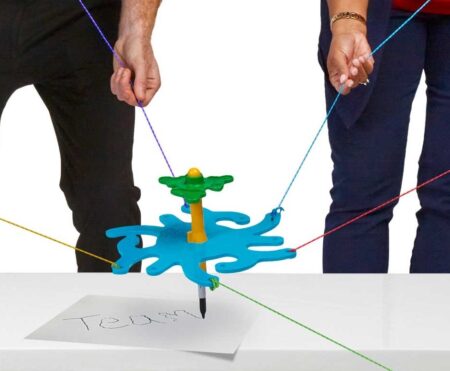Easy Office Games to Strengthen Collaboration
Bring Teams Together—Within and Across Departments
Looking to build stronger, more collaborative teams? These easy-to-facilitate group games help teams improve communication, trust, and mutual understanding. Even better, some of them go a step further—promoting collaboration between multiple teams.
Each of these five best collaborative games is drawn from TrainersWarehouse.com and blog.trainerswarehouse.com, with low-prep setups and high-impact outcomes.

TeamWriter by Trainers Warehouse BUY NOW
1. QUOTE BUILDERS
How it works: In the Quote Builders game, small groups use a deck of hexagonal cards each containing just a few words to reconstruct a famous quotation—without showing each other their cards. They must share information aloud and work together to piece assemble the full quote.
Why it builds collaboration: Each person holds key information, making active listening essential. Ideal for fostering intra-team communication—and can easily be adapted for inter-team collaboration by having teams trade missing pieces across groups. The deck has 18 quotes of varying difficulty, making the challenge fun and not terribly difficult. Through relatively quick success, teams will feel good and build camaraderie. Then they can discuss what the quote means to them individually and as a group.
2. WHAT’S YOUR TAKE? A TEAM DYNAMICS THUMBALL GAME
How it works: Each person takes a turn catching the Team Dynamics conversation starter Thumball. Loaded with “WE” discussion prompts, each recipient answers the question, such as:
- How can we foster greater trust within our team?
- How do we ensure we don’t duplicate efforts?
- How do we gain commitment?
- How should we manage disagreements?
- Give an example of a goal we are all working towards
- Do we have clearly defined team goals?
As teams share and discuss their answers, they’ll discover shared themes, surprising differences, and ways they can better collaborate. This is one of our favorite collaborative games in the mix!
Why it builds collaboration: This open-ended discussion cultivates mutual respect and understanding, as well as tactical ways to improve methods of teaming.
3. Minefield Maze
How it works: In the Blindfold Maze Game, one team member guides blindfolded teammate(s) through an obstacle course using only verbal instructions. Then roles rotate. In larger groups, different teams can navigate the same course simultaneously, creating a need to coordinate movement and timing across teams. To increase the difficulty, challenge teams to get as many teammates across the maze as possible.
Why it builds collaboration: This experience encourages trust and highlights the need for precise communication, and when multiple teams share the same course, they must collaborate to avoid collision and chaos. Alternatively, if the game is played with multiple “guides,” they must collaborate in order not to confuse the blindfolded players.
4. Pass the Clap
How it works: In a large circle, participants “pass” a synchronized clap to their neighbor. Add multiple claps circulating at once, reverse directions, or create patterns that require timing coordination between subgroups. As a variation, have a designated team player leave the room to share the clap pattern with another team/department. See how lapses in time, memory, or clarity can change the “message” forwarded to others.
Why it builds collaboration: This one is simple yet fun, energizing, and useful. It can quickly reveal how miscommunication can ripple through a system. It’s also great to highlight how miscommunications can inadvertently happen when communicating across teams.
5. TeamWriter™
How it works: A “TeamWriter” is a gizmo that allows up to 10 players to hold a single Sharpie marker. The challenge is for team players to figure out where to attached the strings, what to write, how to guide the marker, and how to orient the page.
Why it builds collaboration: Players must work together to sort out how to write a meaningful message. As participants “play,” typical roles will likely emerge, where some are natural leaders, others are followers; some watch and some to; some talk and some listen; etc. Use the experience just for fun or to reflect on communication styles in a non-threatening, non-work-related application.
FACILITATION TIPS
Group size: Most of these games work well for 4–12 players per team. Depending on organizational needs and goals, consider mixing folks from different departments or bringing together different departments that will need each other’s skills or resources to complete the task.
Time needed: Plan on 10–20 minutes per activity, including debrief. Remember that debriefing is the primary reason to take time from work to play a game!
Debriefing makes the magic: Even if the goal is just to have fun, consider debriefing collaborative games with these three questions:
1. “What worked well?”
2. “What could we do differently next time?”
3. “How can we apply our learning here to our real work?”
Final Thoughts
If your teams are stuck in silos or struggling to work together, these simple, engaging games are the perfect antidote. This list of five best collaborative games will build connections, expose communication gaps, and reinforce the value of collaborative problem-solving—all while having fun.
Whether within a single team or across departments, collaborative play plants the seeds for stronger, smarter teamwork.
READ MORE on DEBRIEFING BEST COLLABORATIVE GAMES
Infographic on Picking the Perfect Team Game

